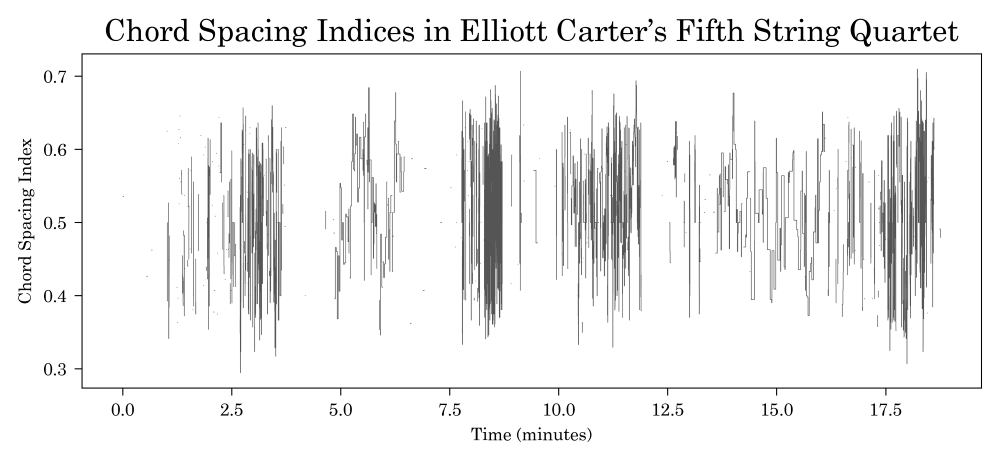research
My research is focused on computer‐assisted composition, analysis, and audio synthesis. You can read more about my software on the Software page, or you can visit my GitHub page.
Balanced Chord Spacing in Elliott Carter's Fifth String Quartet
For this project, I wrote a program to study the use of pitch in Elliott Carter's String Quartet No. 5, with a focus on register and chord spacing. This paper was presented at Music Theory Midwest 2024.
The graph below shows one of the key findings of my paper – that Carter's use of chord spacing is “balanced” in his Fifth Quartet. Balanced chord spacing is defined by two things. First, an imaginary central “axis” halfway between the highest and lowest pitches in the chord indicates the point of “balance.” Second, if you compute the mean of the pitches in a chord, and the mean falls on or near the point of balance, the chord spacing is balanced. Balance is identified by a chord spacing index in the interval (0, 1). A balanced chord has a spacing index of 0.5.
However, individual chord spacing indices can vary wildly from chord to chord. The graph looks like it is visualizing density in some regions because of how quickly the spacing index changes. The Fifth Quartet is still balanced, though, because the mean spacing index in the entire piece, as well as in each of its twelve sections, is close to 0.5. Thus, chords with a high spacing index are balanced out by chords with a low spacing index.

Abstract
Elliott Carter’s Fifth Quartet marks the beginning of his late-late style, in which harmony, rhythm, and counterpoint are simplified. Existing scholarship demonstrates that in this piece, Carter employs flexibility in the use of long-range polyrhythms as well as a concise harmonic language based on the all-interval tetrachords, the all-trichord hexachord, and unions of these set-classes. However, other musical dimensions such as register and voicing receive less attention, and as such, this study focuses on chord spacing trends in the Fifth Quartet, with special emphasis on the Adago sereno and Capriccioso movements. A computer program written for this project segments the score of the quartet by sonority, extracting features for each chord such as chord spacing contour and chord spacing index. These metrics indicate how pitches are distributed vertically within a chord, and where pitches in a chord might be closer together or farther apart in register. This makes it possible to compare all the chords in the piece and notice local and global trends in pitch distribution within chords. The data show that in both movements, as well as in the Fifth Quartet as a whole, Carter chooses to emphasize relatively balanced pitch distribution and balanced chord spacing. In particular, although extremes in spacing choices add occasional drama to the musical narrative, balance is maintained by complementary extremes which restore overall equilibrium.
You can read the paper here. The repository for my analysis software is here.